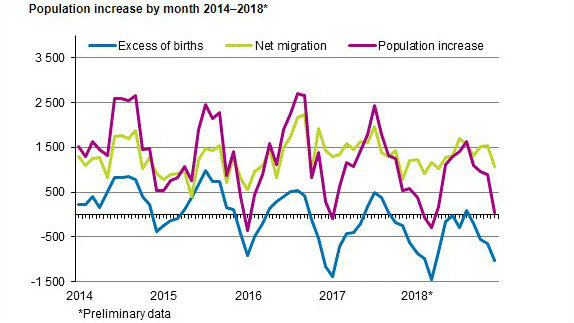During the year 2018 Finland's population increased by 8,643 persons, which is 2,780 less than in 2017. At the end of the year the country's population was 5,521,773 persons, according to the preliminary data for 2018 published Statistics Finland.
The Finnish statistical office remarks that "the reason for the population increase was migration gain from abroad". In this sense, Statistics Finland highlights that in 2018 the number of immigrants was 15,631 higher than that of emigrants.
This positive migratory balance has made it possible to counteract the fact that once again the excess of births was negative as the number of births was 6,988 lower than that of deaths. The preliminary total fertility rate was the lowest in the measuring history, 1.40 children per woman of childbearing age.

Source: Statistics Finland
According to the preliminary statistics, during 2018 a total of 47,307 children were born, which is 3,014 fewer than in 2017. The number of deaths was 54,295, which is 573 higher than one year earlier.
Altogether 31,720 persons immigrated to Finland from abroad and 16,089 persons emigrated from Finland during 2018. The number of immigrants was 77 lower and the number of emigrants 884 lower than in the previous year. In all, 8,571 of the immigrants and 10,788 of the emigrants were Finnish citizens.
The number of inter-municipal migrations totalled 289,223 in 2018. Compared with the previous year, the increase was 1,384 migrations according to the municipal division of 2018.
Same-sex marriages
Same-sex marriages took legal effect in March 2017. During 2018, a total of 211 women and 120 men entered into a marriage in which the spouse was of the same sex. In all, 149 women and 80 men changed their registered partnership into marriage.
According to preliminary data by region, the population grew in 2018 only in Uusimaa, Pirkanmaa, Varsinais-Suomi, North Ostrobothnia and Åland.
The population grew most in absolute numbers in Uusimaa, by 17,895 persons. The next largest increase in population was seen in Pirkanmaa, 3,263 persons. Relative to the population, population increase was highest in Åland (11 per mil), in Uusimaa (10.7 per mil) and in Pirkanmaa (6.4 per mil).
Population loss was highest in absolute numbers in the region of Etelä-Savo, that lost 2,554 persons. The population of Kymenlaakso decreased by 2,000 persons, which was the second biggest loss. Relative to the population, the biggest population loss was found in Etelä-Savo, 17.5 per mil.
Migration gain or loss by region
Most migration gain from intramunicipal and international migration was collected by Uusimaa (14,067 persons) and Pirkanmaa (3,605 persons). Most migration gain in relative terms based on total net migration was attained by Åland (10.6 per mil) and Uusimaa (8.4 per mil).
In absolute numbers, migration loss from total net migration was biggest in the region of Etelä-Savo, 1,272 persons. In the region of Kymenlaakso the loss was 781 persons. In relative terms, the biggest migration loss from total net migration was found in the region of Etelä-Savo (8.7 per mil).
During 2018, migration between regions numbered 136,875. The positive gain from migration between regions was seen in Uusimaa, Pirkanmaa, Varsinais-Suomi and Åland.
In absolute numbers, the highest gain from migration between regions was received by Uusimaa, 6,747 persons. The relative migration gain was highest in Pirkanmaa (5.1 per mil).
Migration loss from migration between regions was biggest in absolute numbers in the region of Etelä-Savo, 1,519 persons.
Migration loss from migration between regions was biggest in relative terms also in the region of Etelä-Savo, 10.4 per mil of the population, according to the preliminary data published by Statistics Finland.











